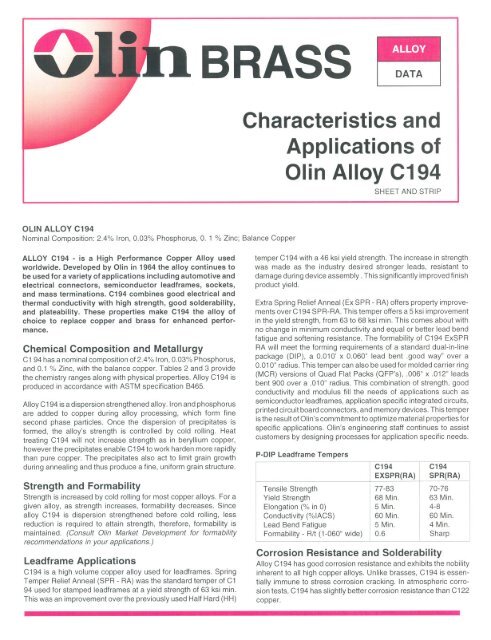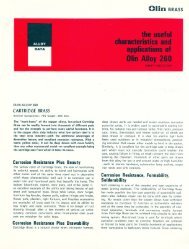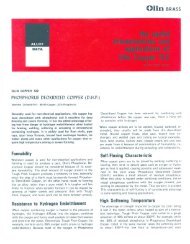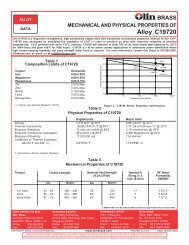olin alloy c194 - Olin Brass
olin alloy c194 - Olin Brass
olin alloy c194 - Olin Brass
You also want an ePaper? Increase the reach of your titles
YUMPU automatically turns print PDFs into web optimized ePapers that Google loves.
~ " ~<br />
BRASS !<br />
Ii<br />
. .<br />
i.."j J'<br />
OLIN ALLOY C194<br />
Nominal Composition: 2.4% Iron, 0.03% Phosphorus, O.1 % Zinc; Balance Copper<br />
ALLOY C194 - is a High Performance Copper Alloy used<br />
worldwide. Developed by <strong>Olin</strong> in 1964 the <strong>alloy</strong> continues to<br />
be used for a variety of applications including automotive and<br />
electrical connectors, semiconductor leadframes, sockets,<br />
and mass terminations. C194 combines good electrical and<br />
thermal conductivity with high strength, good solderability,<br />
and plateability. These properties make C194 the <strong>alloy</strong> of<br />
choice to replace copper and brass for enhanced performance.<br />
Chemical Composition and Metallurgy<br />
C1 94 has a nominal composition of 2.4% Iron, 0.03% Phosphorus,<br />
and 0.1 % Zinc, with the balance copper. Tables 2 and 3 provide<br />
the chemistry ranges along with physical properties. Alloy C194 is<br />
produced in accordance with ASTM specification B465.<br />
Alloy C194 is a dispersion strengthened <strong>alloy</strong>. Iron and phosphorus<br />
are added to copper during <strong>alloy</strong> processing, which form fine<br />
second phase particles. Once the dispersion of precipitates is<br />
formed, the <strong>alloy</strong>'s strength is controlled by cold rolling. Heat<br />
treating C194 will not increase strength as in beryllium copper,<br />
however the precipitates enable C194 to work harden more rapidly<br />
than pure copper. The precipitates also act to limit grain growth<br />
during annealing and thus produce a fine, uniform grain structure.<br />
Strength and Formability<br />
Strength is increased by cold rolling for most copper <strong>alloy</strong>s. For a<br />
given <strong>alloy</strong>, as strength increases, formability decreases. Since<br />
<strong>alloy</strong> C194 is dispersion strengthened before cold rolling, less<br />
reduction is required to attain strength, therefore, formability is<br />
maintained. (Consult <strong>Olin</strong> Market Development for formability<br />
recommendations in your applications.)<br />
Leadframe Applications<br />
C194 is a high volume copper <strong>alloy</strong> used for leadframes. Spring<br />
Temper Relief Anneal (SPR - RA) was the standard temper of C1<br />
94 used for stamped leadframes at a yield strength of 63 ksi min.<br />
This was an improvement over the previously used Half Hard (HH)<br />
DATA<br />
Characteristics and<br />
Applications of<br />
<strong>Olin</strong> Alloy C194<br />
SHEET AND STRIP<br />
temper C 194 with a 46 ksi yield strength. The increase in strength<br />
was made as the industry desired stronger leads, resistant to<br />
damage during device assembly. This significantly improved finish<br />
product yield.<br />
Extra Spring Relief Anneal (Ex SPR - RA) offers property improvements<br />
over C194 SPR-RA. This temper offers a 5 ksi improvement<br />
in t~e yield strength, from 63 to 68 ksi min. This comes about with<br />
no change in minimum conductivity and equal or better lead bend<br />
fatigue and softening resistance. The formability of C194 ExSPR<br />
RA will meet the forming requirements of a standard dual-in-line<br />
package (DIP), a 0.010' x 0.060" lead bent .good way" over a<br />
0.010" radius. This temper can also be used for molded carrier ring<br />
(MCR) versions of Quad Flat Packs (QFP's), .006" x .012" leads<br />
bent 900 over a .010" radius. This combination of strength, good<br />
conductivity and modulus fill the needs of applications such as<br />
semiconductor leadframes, application specific integrated circuits,<br />
printed circuit board connectors, and memory devices. This temper<br />
is the result of <strong>Olin</strong>'s commitment to optimize material properties for<br />
specific applications. <strong>Olin</strong>'s engineering staff continues to assist<br />
customers by designing processes for application specific needs.<br />
P-DIP Leadframe Tempers<br />
C194 C194<br />
EXSPR(RA) SPR(RA)<br />
Tensile Strength 77-83 70-76<br />
Yield Strength 68 Min. 63 Min.<br />
Elongation (% in 0) 5 Min. 4-8<br />
Conductivity (%IACS) 60 Min. 60 Min.<br />
Lead Bend Fatigue 5 Min. 4 Min.<br />
Formability - R/t (1-060" wide) 0.6 Sharp<br />
Corrosion Resistance and Solderability<br />
Alloy C194 has good corrosion resistance and exhibits the nobility<br />
inherent to all high copper <strong>alloy</strong>s. Unlike brasses, C194 is essentially<br />
immune to stress corrosion cracking. In atmospheric corrosion<br />
tests, C194 has slightly better corrosion resistance than C122<br />
copper.
C194 exhibits excellent solderability and plateabilitydue to the benign<br />
nature of its oxides. The surface of C194 is easily cleaned, fluxed and<br />
wet bysolders or brazing <strong>alloy</strong>s.The solderabilityofC194 is equal to that<br />
of C110, C197, and C510 bronze. C194 has superior solderability<br />
compared to C260 brass. Table 1 shows the dip solderability and<br />
solderability shelf lifeof C194 and the competitive <strong>alloy</strong>s.<br />
Dip solderability testing was conducted on freshly cleaned samples<br />
using rosin based, nonactivated flux.The solderability rating of Class I<br />
being the best and Class V the worst. For most electrical/ electronic<br />
applications a Class I to 11 solderability rating (MIL-SRD-883) is<br />
considered acceptable.<br />
C194 is also available preplated withtin, solder, or other coatings. For<br />
optimum solderability and solderability shelf life,a preplate of Hot Air<br />
Leveled Tin with a thickness of 100 microinches minimum is recommended.<br />
Contact your local <strong>Olin</strong>sales officefor informationon Hot Air<br />
Leveled Tin plating.<br />
Table 1<br />
Dip Solderability*<br />
common <strong>alloy</strong>s.<br />
and Shelf Life of C 194 and other<br />
Exposure Time (hours)<br />
Alloy 0 100 1000 5000<br />
C110 I II II III<br />
C194 I II III IV<br />
C260 IV IV IV IV<br />
C425 II III IV IV<br />
C510 I III III<br />
*Unactivated Rosin Flux (Alpha 100)<br />
Alloys are ranked according to the dip test method performed to MIL Std.<br />
202D Method 208B. Aftercleaning and ageing, rankings are defined as:<br />
I - Ideal coating, bright, smooth, and no surf<br />
irregularities.<br />
II - Continuous coating, no dewetting, 1% or less pin holes,<br />
non-uniform solder thickness.<br />
III - Dewetting on up to 50% of the test area, up to 10% pin<br />
holes.<br />
IV - Dewetting on more than 50% of the test area, more than<br />
10% pin holes.<br />
Softening Resistance<br />
Copper and high copper <strong>alloy</strong>s, when cold worked, anneal at low<br />
temperatures and the recrystallized grains grow rapidly. This results<br />
inconsiderable softening and loss of strength. Parts which are exposed<br />
to elevated temperatures during fabrication and assembly may subsequently<br />
fail because they have softened excessively.<br />
Leadframes are a perfect example of the type of processing that can<br />
cause parts to soften and subsequently fail.Duringpackaging, they may<br />
be subjected to temperatures as high as 350°C for several minutes.<br />
Figure 1 shows the softening behavior of C194 and some other copper<br />
leadframe materials at 350°C. The resistance to softening exhibited by<br />
C194 enables it to maintain the strength required to resist deformation<br />
in handling and automated assembly of the device onto a printed circuit<br />
board.<br />
Softening resistance is achieved through the dispersion offine intermetallic<br />
particles in the matrix.<br />
100<br />
80<br />
~~ 60<br />
-= C><br />
c:<br />
!!!<br />
li5 40<br />
"C<br />
:a><br />
>-<br />
20<br />
0<br />
0 1 10<br />
Exposure Time (minutes)<br />
Figure 1: Softening Behavior of Leadframe Materials at 350°C<br />
Con nector Appl ications<br />
AlloyC194 offers a combination of strength, good formability,electrical<br />
and thermal conductivitywhich are useful to the interconnect designer.<br />
C194 can be used when copper C110 and others lack sufficient<br />
strength. Furthermore, C194's resistance to softening allows itto retain<br />
strength after extended periods at elevated temperatures. C194 can be<br />
selected to replace the brass <strong>alloy</strong>s when improved solderability is<br />
required.<br />
Reliabilityof the interconnect is vitallyimportant as well. Stress Relaxation<br />
resistance is criticalto the maintenance of contact force over the<br />
lifeof an interconnect and therefore plays a role in the reliabilityof the<br />
system. Figure 2 shows the stress relaxation behavior of C194 as it<br />
compares to other copper <strong>alloy</strong>s. Alloys C110 and C260, though<br />
commonly used, exhibit quite poor stress relaxation behavior and are<br />
not recommended forstress relaxation criticalapplications at elevated<br />
temperatures. Alloy C194 has good stress relaxation resistance to<br />
temperatures of 105°C and issuperiortocopperC11 0 and brass C260.<br />
100<br />
...<br />
c<br />
:E 80<br />
I. 70<br />
-- C151<br />
C155<br />
('.194 !<br />
. .<br />
. .<br />
: . : .<br />
..-..-- .......................-..l.......................................--......\...............-..............--...<br />
i .<br />
i .<br />
C102<br />
.<br />
.<br />
.<br />
.<br />
.<br />
.<br />
.<br />
.<br />
: "'-"""""""",-,""""""""""""'"<br />
Iii 60 =<br />
:e<br />
'0 so<br />
If. C110<br />
010.<br />
1 10<br />
100 1000 10000 ,00000<br />
Expo.uno TIme (hours)<br />
Figure 2: Stress relaxation performance of C 194 Hard (HRO4) VB.<br />
selected hard temper copper <strong>alloy</strong>s at 7SOC.<br />
<strong>Olin</strong> <strong>Brass</strong> is fully committed to the research and development of copper<br />
base <strong>alloy</strong> strip. In total, <strong>Olin</strong> offers eight high performance copper <strong>alloy</strong>s<br />
including: C151, C194, C195, C197, C638, C654, C655, C688, C7025.<br />
<strong>Olin</strong> also offers beryllium copper strip, which compliments a portfolio of<br />
<strong>alloy</strong>s unequaled in the world.<br />
100
OLIN ALLOY C194<br />
TABLE 2: Composition and Physical Property Data for C194<br />
NOMINAL COMPOSITION: 97.4% Copper<br />
2.4% Iron<br />
0.03% Phosphorus<br />
0.1% Zinc<br />
COMPOSITION LIMITS: Copper<br />
Iron<br />
97.4% Min.<br />
2.1-2.6%<br />
Phosphorus<br />
0.015-0.15%<br />
Zinc<br />
0.05-0.2%<br />
Lead 0.03% Max.<br />
Other Impurities<br />
0.1% Max.<br />
Physical Properties:<br />
Melting Point (Liquidus)<br />
Melting Point (Solidus)<br />
Density<br />
Thermal Conductivity (Annealed)<br />
English Units<br />
1992°F<br />
1981°F<br />
.322 Ibsl in3<br />
150 Btu-ft/fF-hr-Fo @ 68°F<br />
Metric Units<br />
1089°C<br />
1083°C<br />
8.92 gm/cm3<br />
0.625 cal-cm/cm2 -see-Co @20°C<br />
Coefficient of Thermal Expansion 0.0000097/"F (68 - 572°F) 0.0000174/°C (20 - 300°C)<br />
Electrical Resistivity (Annealed) 17 ohm circ mils/ft @ 68°F 2.87 microhm-em @20°C<br />
Electrical Conductivity (Annealed) 60% LAC.S.t @ 68°F 0.348 megmho/cm @20°C<br />
Modulus of Elasticity (Tension) 17,500,000 psi 12,300 kg/mm2<br />
Coefficient of Thermal Expansion 0.00000981 of (68 - 572 OF) 0.00001761 °C (20 - 300 DC)<br />
0.00000961 of (68 - 392 OF) 0.0000172 1°C (20 - 200 DC)<br />
0.00000931 of (68 - 212 OF)<br />
0.00001671 °C (20 - 100 DC)<br />
tlnternational Annealed Copper Standard<br />
TABLE 3: Typical Mechanical Property Data for C1 9400<br />
Yield Strength<br />
Tensile Strength (0.2% offset) Nominal Elongation<br />
% in 2" (51mm.)<br />
Temper ksi kgf/mm ksi N/mm2<br />
(Annealed Tempers)<br />
Soft Anneal 40-50 275-345 22 Max. 152 Max. 29 Min.<br />
Light Anneal 45-55 310-380 23 160 26<br />
Special Light Anneal 53-63 365-435 37 255 14<br />
(Rolled Tempers)<br />
1/2 Hard (1-102) 53-63 365-435 45 310 17<br />
Hard (1-104) 60-70 413-483 60 413 7<br />
Extra Hard (1-106) 67-73 460-503 67 460 2<br />
Spring (1-108) 70-76 483-525 70 483 2<br />
Extra Spring (1-110) 73-80 503-552 73 503 2 Max.
OLIN BRASS<br />
MAIN OFFICE AND MILL<br />
East Alton, Illinois 62024-1197<br />
Phone: 618-258-2000<br />
Fax: 618-258-3481<br />
www.<strong>olin</strong>brass.com<br />
SOMERS THIN STRIP<br />
MAIN OFFICE AND MILL<br />
215 Piedmont Street<br />
Waterbury, Connecticut 06720<br />
Phone: 203-597-5000<br />
Fax: 203-597-5068<br />
INTERNATIONAL SALES HEADQUARTERS<br />
<strong>Olin</strong> <strong>Brass</strong><br />
427 North Shamrock Street<br />
East Alton, Illinois 62024-1197<br />
Phone: 618-258-2000<br />
Fax: 618-258-3713<br />
<strong>Olin</strong> BRASS<br />
COPYRIGHT@1993, OLIN CORPORATION PRINTED IN U.S.A. ZBSA-93 (300)







